Paste the link if you don't receive the images/can't access the video.
http://www.viewzone2.com/H1N1.html
Love and Light.
David
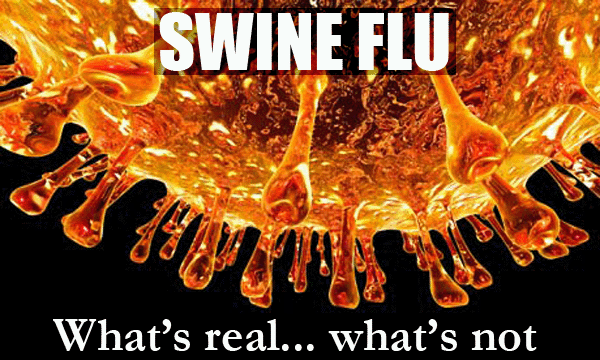
The Swine Flu - what's real and what's not.
Dan Eden for viewzone.com
Unless you've been in a coma for the last few years, you've heard about "swine flu". Last winter the health officials declared it a global pandemic, meaning it had spread to so many different geographic locations that there was no way to isolate or stop it. This all sounds quite frightening, like some doomsday movie plot. We need to know the facts and decide what is worth worrying about and what just sounds scarey.
I lived in Vietnam during the "bird flu" epidemic and covered this for Viewzone in 2004. The government acted quickly there, killing everything with wings, including pet canaries and caged songbirds. You couldn't order any chicken in restaurants and "pho ga", the national dish, was virtually outlawed.
Despite predictions that it would kill 40 to 50 percent of its victims, the "bird flu" eventually went away. The virus mutated (changed) and became less lethal. This ability of the virus to change is important to understand. Flu virus, whether it is called "swine" or "bird" has a kind of "life" and "intelligence" -- even though it is not really alive at all.
What is the H1N1 virus?
A "living" organism is usually something like a plant or animal which takes in food, has a metabolism, excretes wastes and reproduces. A virus is different. It really has no internal organs and does not move or eat food. In fact, it only reproduces copies of itself -- and it doesn't even do that by itself.
If you looked at a virus in a powerful microscope, you would see a sphere with a protein shell containing many little bumps and barbs [below]. If you cut it open you would find that it contains a single strand of RNA with its unique genetic code.
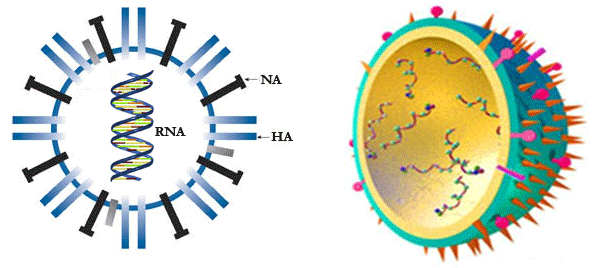
Influenza is another name for the flu, which you have probably had at some time in your life. Viruses that cause influenza in animals, including humans, are called "Type A" viruses. The "swine flu" virus (technically known as H1N1) is a type A virus.
There are many different subtypes of Type A viruses. These subtypes differ because of changes in certain proteins (those bumps and barbs on the shell) called hemagglutinin [HA] and neuraminidase [NA].
There are 16 known HA subtypes (numbered #1 through #16) and 9 known NA subtypes (numbered #1 through #9) of influenza A viruses. Many different combinations of HA and NA proteins are possible. Each combination represents a different subtype. The technical name for the "swine flu" is H1N1, meaning it has a shell with #1 HA and #1 NA.
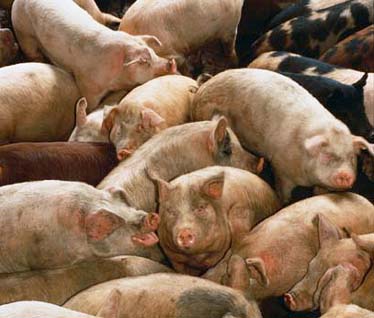 All known subtypes of Type A viruses can be found in birds. Pigs, or "swine" usually can harbor three types of type A virus (H1N1, H3N2 and H1N2). Some type A virus only makes birds mildly sick but others can be fatal. When swine get the type A virus it is usually mild with a slight fever, dripping nose and fatigue -- not unlike a mild cold. It is seldom fatal.
All known subtypes of Type A viruses can be found in birds. Pigs, or "swine" usually can harbor three types of type A virus (H1N1, H3N2 and H1N2). Some type A virus only makes birds mildly sick but others can be fatal. When swine get the type A virus it is usually mild with a slight fever, dripping nose and fatigue -- not unlike a mild cold. It is seldom fatal.
The shell containing the HA and NA is important because that's how a virus infects, or gets inside a cell, whether it is a pig or a human cell. Scientists call it the "lock and key" mechanism. Animal cell walls contain proteins that react when they are in contact with the virus shell proteins. Only certain protein molecules can react with other protein molecules and create openings, exposing the inner contents of the host cell wall to contaminants from the virus. This is how the single strand of RNA inside the H1N1 virus gets in to a pig or human cell. It's the reason that this virus can infect a human and be essentially harmless to, say, a plant or a dog or an elephant.
Is it alive or not?
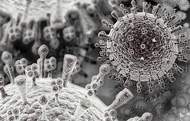 Remember, the virus doesn't move. It doesn't "swim" of "fly" or "stalk" the host cell. In that sense it is not really "alive" -- and so it cannot technically be "killed." It merely comes in contact with its host cell and the molecular structure of its protein shell does the rest. Once the cell wall has been "unlocked" and the virus RNA has entered the host, more chemical reactions automatically take place inside the attacked cell.
Remember, the virus doesn't move. It doesn't "swim" of "fly" or "stalk" the host cell. In that sense it is not really "alive" -- and so it cannot technically be "killed." It merely comes in contact with its host cell and the molecular structure of its protein shell does the rest. Once the cell wall has been "unlocked" and the virus RNA has entered the host, more chemical reactions automatically take place inside the attacked cell.
The virus RNA molecule uses the cell contents to manufacture duplicate copies of itself along with more HA-1 and NA-1 protein shells to encapsulate them. It uses the molecules inside the attacked cell to do this. Usually it can find all of the basic building blocks to make copies of itself but occasionally it picks up some of the attacked cell's genetic material and accidentally incorporates it into the copies.
The process continues unfailingly until the attacked cell's contents are either depleted or until the cell literally explodes, distributing more copies of the virus to infect neighboring cells.
Pretty scary - right? But remember that viruses are part of our environment. We have all been infected by them, from chickenpox when we were a child to last year's flu or bad cold. Usually they are not lethal. So why is swine flu different?
The hallmark of the Influenza A virus is the ability to suddenly change. This change can alter the types of HA and NA proteins on its shell, or it can alter the code contained in its RNA.
The changes in the shell subtypes are called "Drift" and this usually changes the ability of the virus to get inside a particular group of cells which are vulnerable to the types of NA and HA which "unlock" its cell membranes.
Another type of change called "Shift" and this is the one that is responsible for the H1N1 "swine flu" pandemic.
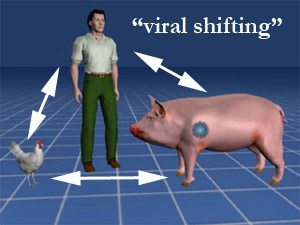 With "Shift" you have two or more virus strains which have the correct HA NA on their cells to successfully attack and invade a host cell. They can have different subgroups (for example: H1N1, H3N2 and H1N2 can all invade a pig cell) and enter a cell, releasing their RNA. If this happens at the same time, it is possible that some of the RNA will be re-mixed and combined in new ways, producing copies that are similar -- but not identical -- to the original invading virus. It can also happen if the virus goes from one animal to another, and to another...
With "Shift" you have two or more virus strains which have the correct HA NA on their cells to successfully attack and invade a host cell. They can have different subgroups (for example: H1N1, H3N2 and H1N2 can all invade a pig cell) and enter a cell, releasing their RNA. If this happens at the same time, it is possible that some of the RNA will be re-mixed and combined in new ways, producing copies that are similar -- but not identical -- to the original invading virus. It can also happen if the virus goes from one animal to another, and to another...
The result can be a new strain of the virus that can either be milder or possibly lethal. This is what appears to have happened with the H1N1 virus pandemic. Examination of the virus revealed genetic codes from birds, pigs and humans.
The genetic make-up of this swine flu virus is unlike any other: it is an H1N1 strain that combines a triple assortment first identified in 1998 including human, swine, and avian influenza with two new pig H3N2 virus genes from Eurasia, themselves of recent human origin.
At first, it was feared that humans were contracting the virus from pigs. Hundreds of thousands of pigs were slaughtered around the world. Then it was established that human-to-human contact was the route of infection. By then the virus was everywhere.
More than just a cold?
There are many types of H1N1 virus. Remember, that's just the shell. The difference between the seasonal H1N1 flu that you've probably had before and the so-called "swine flu" is the RNA inside the virus capsule.
 Every year, the seasonal flu kills around 36,000 to 40,000 Americans and hospitilizes around 200,000. Right now there are just hundreds of cases of H1N1 deaths in America. According to the Center for Disease Control (CDC), the proportion of deaths attributed to pneumonia and influenza (P&I) based on the 122 Cities Report continues to increase and has been higher for five weeks now than what is expected at this time of year from the seasonal H1N1 flu. This suggests that the "swine" version of H1N1 can do more damage to lung tissues than the seasonal variety.
Every year, the seasonal flu kills around 36,000 to 40,000 Americans and hospitilizes around 200,000. Right now there are just hundreds of cases of H1N1 deaths in America. According to the Center for Disease Control (CDC), the proportion of deaths attributed to pneumonia and influenza (P&I) based on the 122 Cities Report continues to increase and has been higher for five weeks now than what is expected at this time of year from the seasonal H1N1 flu. This suggests that the "swine" version of H1N1 can do more damage to lung tissues than the seasonal variety.
Demographics has shown that the pandemic prefers to attack a younger population. This suggests that the H1N1 may contain genetic material similar to the flu of 40 to 50 years ago. Older people may still have immunity to these older strains while the younger populations may be more vulnerable. Most fatalities currently are in the age group of 19-40, followed by the 41-55 age group.
According to Dr. Henry Niman of Recombinomics, the most vulnerable are young, healthy adults. This is because, according to Dr. Niman, "It is the strong reaction of the immune system that causes the complications and death... Those with weaker immune systems -- the very young and old -- will have milder symptoms, similar to the regular, seasonal flu."
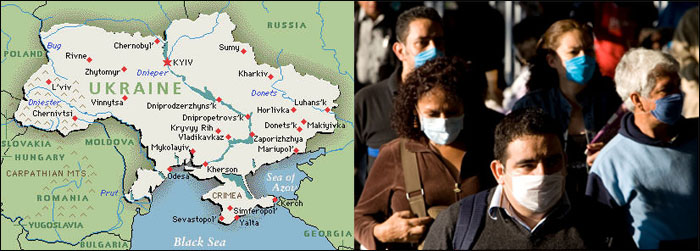
Currently, all eyes are focused on the Ukraine where more than a million cases of the swine flu have been reported along with hundreds of deaths. Autopsies on the dead showed that the victims had died from hemorrhagic pheumonia. This could possibly signal that the virus had undergone a mutation and may be getting more potent.
"The symptoms are observed at different stages of disease - a fever with a temperature over 38 C, cough, respiratory disorders. When cough was characterized by negligible allocation phlegm or dry unproductive cough with blotches of blood. All the patients come to hospital on average by 3-7 days of onset, were in serious condition. Period of time from onset to death averaged from 4 to 7 days. In all patients during a hospital for signs of respiratory insufficiency of various degrees, which quickly rose and manifested accelerated respiration rate, shortness of breath and effectiveness of independent breathing. X-ray studies were performed on 1-2 day hospitalization. Most patients experienced a double-headed particles of lower lung lesion, followed by a trend towards total destruction." --Recombinomics Commentary 04:22, November 9, 2009
[Above] Returning soldiers celebrated the end of WW1, only to be killed by the horrible flu pandemic of 1918. The virus had mutated to a deadly form, capable of killing a person in less than 24 hours! Nine decades on, we are preparing for a winter in which swine flu may mutate into a widespread killer. It is undeniably an unpleasant disease -- sufferers tell of agonising sore throats, sheet-drenching sweats, uncontrollable vomiting, and a lethargy that confines you to bed for a full week -- but the 1918-1919 influenza virus that swept the world was even nastier.
"Those afflicted were first aware of a shivery twinge at breakfast. By lunchtime, their skin had turned a vivid purple, the colour of amethyst or the sinisterly beautiful shade of the heliotrope flower. By the evening, before there was time to lay the table for supper, death would have occurred, often caused by choking on the thick scarlet jelly that suddenly clogged the lungs. Between 50 and 100 million people across the world died of what became known as Spanish Flu." |
Intelligent virus: Darwinism and Destruction
Darwin's theory of evolution shows that organisms change over time to adapt to their environment and to survive. Survival is defined as living long enough to reproduce and continue the existence of the particular species.
An organism that kills its host in the process of reproducing itself gradually diminishes its own survival. Eventually there are no more hosts to infect and it becomes extinct. Thus, many scientists think that the H1N1 virus will eventually evolve into a less lethal entity. That's the good news. The bad news is that the virus has chosen humans as its preferred host. There's a lot of us to infect before the supply of humans runs out.
The great influenza pandemic of 1918 - 1919, caused an estimated 40 to 50 million deaths worldwide, followed by pandemics in 1957 - 1958 and 1968 - 1969.
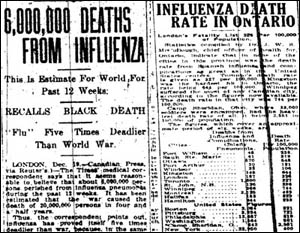 The 1918 "Spanish" flu pandemic is estimated to have infected up to one billion people -- half the world's population at the time. The virus killed more people than any other single outbreak of disease, surpassing even the Black Death of the Middle Ages. Although it probably originated in the Far East, it was dubbed "Spanish" flu because the press in Spain -- not being involved in World War I -- were the first to report extensively on its impact. The virus caused three waves of disease. The second of these, between September and December 1918, resulting in the heaviest loss of life.
The 1918 "Spanish" flu pandemic is estimated to have infected up to one billion people -- half the world's population at the time. The virus killed more people than any other single outbreak of disease, surpassing even the Black Death of the Middle Ages. Although it probably originated in the Far East, it was dubbed "Spanish" flu because the press in Spain -- not being involved in World War I -- were the first to report extensively on its impact. The virus caused three waves of disease. The second of these, between September and December 1918, resulting in the heaviest loss of life.
It is thought that the virus may have played a role in ending World War I as soldiers were too sick to fight, and by that stage more men on both sides died of flu than were killed by weapons. Although most people who were infected with the virus recovered within a week following bed rest, some died within 24 hours of infection.
If you look at the 1918 flu, you see that the virus did not have a high kill rate. It was just 1.5 to 2 percent. But this virus was good at spreading from one host to another, which is what made it extremely dangerous. Consider the potential today with the improvements in air travel and tourism and the potential for global infection is enormous.
Reports, like the one coming from the Ukraine, are carefully monitored and analysis of the RNA is meticulously searched for any variance from the known genetic sequences. Of course, because human cells provide a "mixing bowl" for genetic inclusions, some changes will inevitably occur. It is also possible that the flu could return to infect a swine or bird, change its genetic code, and then re-emerge again in humans with more virulent potential.
Right now the virus, according to the CDC, is still vulnerable to the vaccines and so they advise people to get a flu shot to be safe.
What about the mercury in the flu shots?
 When pharmaceutical companies began making vaccines for large groups of the population, they realized there was a problem. A large bottle with a rubber top received many insertions of the hypodermic needle to draw each dose. This introduces microscopic impurities such as fungus and bacteria inside the unused vaccine liquid and could allow it to grow, harming or even killing the patient.
When pharmaceutical companies began making vaccines for large groups of the population, they realized there was a problem. A large bottle with a rubber top received many insertions of the hypodermic needle to draw each dose. This introduces microscopic impurities such as fungus and bacteria inside the unused vaccine liquid and could allow it to grow, harming or even killing the patient.
Companies began using a very weak solution called thimerosal, which contains 50% mercury, as a preservative. The actual dose you may receive in a vaccination is very small -- about the same as you might receive by eating can of tuna fish. Nevertheless, mercury IS a neuro-toxin and has been linked to some bad side effects and birth disorders.
The thimerosal is NOT used in single dose vaccines, including the nasal sprays, since they will not be subjected to multiple needle punctures or outside contaminants. If you are worried about mercury, ask for the single dose vaccine.
Conspiracy theories?
OK. The aliens have demanded that we reduce Earth's population and form a one world government before we can join the inter-planetary federation. The swine flu vaccine is a plot to kill off millions of people or make them sterile. These are the kinds of things one reads on the blogs and conspiracy web sites.
Hey, if it were true, I'd be the first person tell you about it. But I can honestly say that, after researching this article, there's nothing sinister about the virus or the vaccines.
When I lived in Vietnam and travelled to neighboring Cambodia, I saw hundreds of family farms with duck ponds in the front yard surrounded by pig pens. The family dwelling was in this mix also. Lots of under-developed countries are the same. It's the perfect way to provide food for your family. Unfortunately it's also the perfect breeding ground for these types of virus. There is, therefore, no need to manufacture swine flu in a secret laboratory. It's as natural as human civilization.
I do question the safety of the vaccine -- not because it can contain mercury -- but because there are so many drugs which seem rushed to market, only to later be recalled due to some negative impact that was overlooked by the pharmaceutical companies.
I was recently sent this shocking video in which it was revealed that a pharmaceutical company, Baxter, accidentally (?) shipped 72 kilograms (32 pounds) of material for making the H1N1 vaccine to laboratories in Europe which contained live bird flu virus!
Had the laboratories not tested the material when several of their experimental animals became ill the material might have made its way in to the H1N1 vaccine!
These seemingly impossible mistakes suggest that some pharmaceutical companies may be trying to cause "Shifting" of the H1N1 so that they can benefit by selling vaccines that they have already designed to prevent the disease!
From: Viewzone
http://www.viewzone2.com/H1N1.html





No comments:
Post a Comment